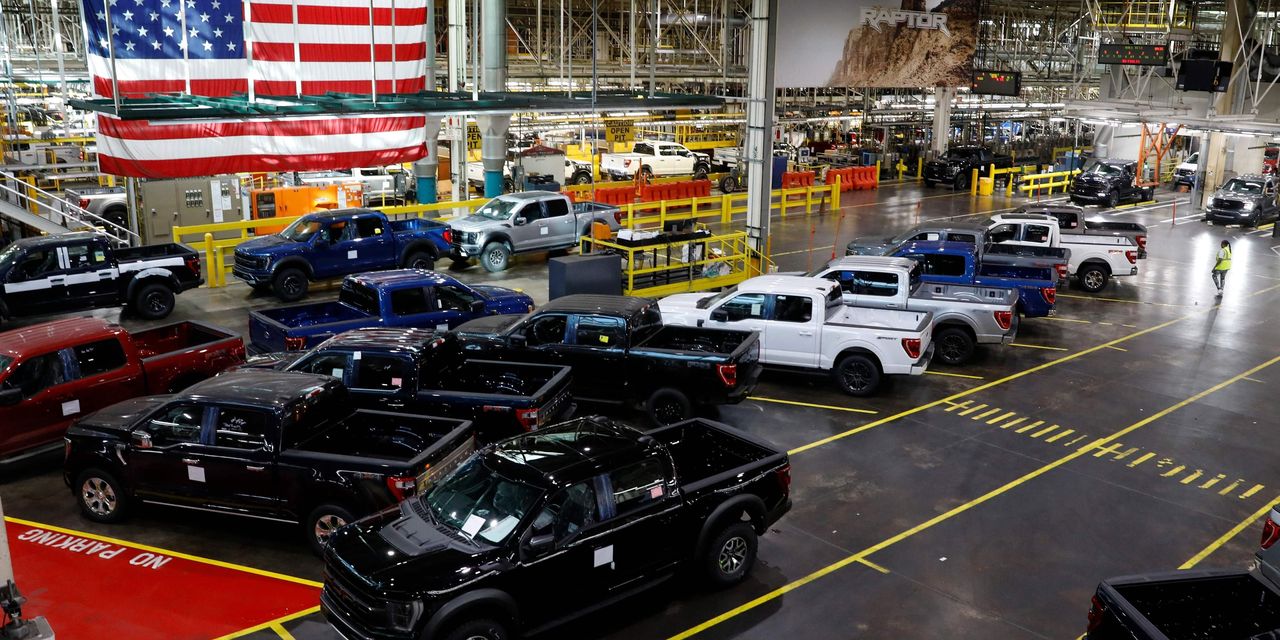A strike affecting one or all of the Big Three automakers “seems inevitable,” Wall Street analysts and auto-industry observers say, with the market’s best hopes for the companies centered on a short strike offset by rising inventories.
“Let me put it this way: Right now, it would be more a surprise if a strike didn’t happen than if it happened,” said Sam Fiorani, vice president of global vehicle forecasting at AutoForecast Solutions.
A strike “seems inevitable” given the gulf between company proposals and union demands, said Karl Brauer, an analyst with iSeeCars.com.
General Motors Co.
GM,
Ford Motor Co.
F,
and Stellantis NV
STLA,
have proposed raises in the low to mid double-digit percentages. Union demands include a 46% wage increase spread out over the life of the new contract as well as a shorter workweek and the end of tiered wages and benefits.
“As with past UAW strikes, the length of any work stoppage will decide how impactful this strike is to the domestic automakers and the larger automotive landscape,” Brauer said.
The autoworkers’ four-year contract expires at midnight Thursday. A strike vote could be called shortly, perhaps even ahead of the contract’s expiration. Workers would put down their tools immediately after a vote to strike, and assembly lines would come to a halt. UAW workers are unlikely to cross the picket line.
See also: GM and Ford’s bonds are already reflecting worries about a possible strike
This year, UAW President Shawn Fain has raised the possibility of striking at all three companies.
But the Associated Press reported late Tuesday that the UAW leadership is considering a strategy of targeted strikes at a limited number of plants, which could be less costly to the union than a widespread strike.
Traditionally, the UAW chooses one company at which to strike, in part to preserve its strike fund and picket-line resources. Fain, who has cultivated a firebrand persona, said last week that the union could strike at all three companies if needed.
The 2019 strike at GM, involving around 50,000 autoworkers, lasted nearly six weeks. It led to an adjusted loss of about $3.6 billion for the company, and GM North America lowered revenue estimates as nearly 300,000 fewer vehicles were delivered.
See also: How much would a strike cost the Big Three automakers? Wall Street thinks it has an answer.
Analysts have played with loss scenarios depending on the duration of the strike, with most calculating losses of a little over $1 billion for the affected company in the case of a strike lasting a couple of weeks.
The strike could hit at a time when inventories, while still not back at prepandemic numbers, have increased. Cox Automotive estimated that U.S. new-car inventories have ticked above 2 million, a level not seen since April 2021.
Inventories stood at 2.06 million units in early September, up from a revised 1.96 million at the start of August, Cox said. “Most domestic brands [are] flush with supply” ahead of the potential strike, with GM’s Cadillac brand having the lowest inventory, with a supply of about 46 days.
Related: Buying a new car? Don’t expect a bargain, even with more vehicles on dealership lots.
While a strike may seem like a foregone conclusion, Bloomberg Intelligence analyst Kevin Tynan said that there are “enough forces pushing from manufacturers, UAW and governments that any stoppage could be significantly shorter than the six weeks” GM and the UAW endured in 2019.
In retrospect, the strike should have been taken as the done deal it is shaping up to be, Fiorani said.
Fain, who narrowly won his post in a runoff election in the spring, “has to make sure he looks tough for the members,” as his predecessors were thought to be too cozy with management, Fiorani said, adding that striking at all three carmakers would definitely be a big break with tradition.
The strike would also hit the U.S. automakers at the heart of their profits: their high-margin trucks and SUVs.
Most pickup trucks, including Ford’s F-150 pickup truck, the best-selling vehicle in the U.S. for decades running, are made in U.S. factories.
One exception for Ford is the Maverick compact truck, which is made in Mexico. Most of GM’s SUV lineup is also made in the U.S., with some GM trucks made in Canada or Mexico.
The strike will also have implications for auto-parts suppliers, as most companies have operations spread through North America. It’s not easy to switch a highly specialized product line to another factory at the drop of a hat.
“As far as companies that are impacted, there won’t be any part of the value chain” that won’t feel the economic impact of the labor action, Bloomberg Intelligence’s Tynan said.
“Perhaps the markets perceive non-unionized foreign or EV-only manufacturers as potential winners, though the disruption to the supply chain will bleed into any company trying to manufacture automobiles in the U.S. and even North America,” he said.
Around half of the vehicles on U.S. roads today are built by non-union workers, either coming in as imports or made in the U.S. in plants that are not unionized.
Tesla Inc.
TSLA,
has for years fended off efforts to unionize its plants, and earlier this year the National Labor Relations Board ordered the electric-vehicle maker to reinstate an employee fired in connection with labor organizing and said Chief Executive Elon Musk must remove a three-year-old social-media post urging against unionizing.
Shares of Ford have gained 7% so far this year, contrasting with losses of 0.5% for GM shares in the same period. Year to date, the S&P 500
SPX
has gained about 16%.
Read the full article here







